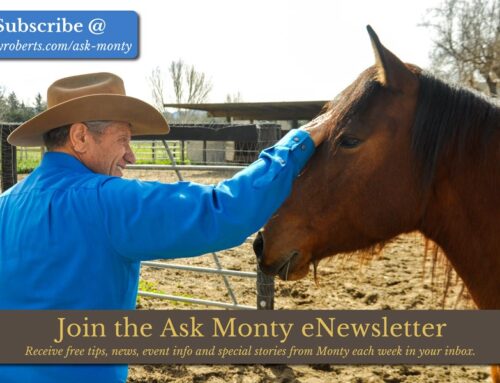Editor’s note: This post from Monty is in response to a Facebook comment raising the issue of hitting a horse that bites. You can also learn about Monty’s quick solution to stop your horse biting here.
Dear Derek,
I couldn’t ask for a better opening of the door for me to explain my position regarding the statements that you made which I am considering a question. Your response is an invitation to thousands to better understand that the human mind, in the horse world, is still not traveling with the mind of the horse. To strike a horse for pain is the world’s #1 worst piece of horsemanship. And while one might perceive the immediate results to be effective the damage done is permanent. To hit a horse anywhere about the head for the act of biting will produce a more effective biter. Your question is perfect to promote learning.
So, you were walking down through the stable and the horse bit you and it hurt so you hit the horse back. Can you immediately see two young lads playing in the sandbox and operating under this same theory. Pretty soon, you have a war and often the parents enter in and the whole thing ends up as a gang rumble. Do you really think that hitting the horse will somehow cause it to rationalize that the next time you walk through the barn he won’t bite you. I have spent 75 years proving that he simply becomes a more dangerous biter. Striking sets a pattern so that after the clamp-down of teeth there is an immediate draw back that really hurts.
In my writings I have consistently suggested way to take the horses brain to another part of their anatomy. One can set it up for the stable as well. The knowing horseman will realize that since we domesticated horses and tend to place them in little rooms for an extended period of their existence, they tend to become territorial. A man’s home is his castle and we tend to believe that for ourselves. There are many ways to deal with territorial behavior and I suggest that you continue to study my concepts as you will undoubtedly evolve to the position that you ultimately will realize that I have done my homework and have addressed your concerns.
It is with regularity that I hear people say “Oh, Monty people don’t believe in striking horses anymore. You have done a great job of educating the world that violence is never the answer.” I appreciate your fortitude in deciding to open this door by coming forward with the comments that I have read from you. It proves categorically that I have NOT finished my mission and that I can’t afford to get old and die. I need to keep getting up every morning and even working harder to learn more so that I can pass it on to those that are still on the curve. Thank you so much for giving me the opportunity to invite you to deeper study my concepts.
Just 3 days ago I dealt with a horse that was extremely head shy. Some groom, owner or veterinarian, farrier or an individual unidentified had chosen to twist ears and strike the horse about the head. Horses don’t lie and this one leaves no room for error, she was abused. By chance I happened on to a procedure that I have never tried before and within 15 minutes I had a student walking up to her, rubbing her ears and massaging her entire head with his hands. These actions would have caused him to receive a front foot between his eyes only a few minutes before. This is a different subject and I will address it at a different time.
Monty Roberts
Editor’s note (2): For solutions on dealing with horses without resorting to violence, and gaining an understanding of the horse’s nature and mindset, please see Monty’s textbook, From My Hands to Yours. You can also sign up for Monty’s free weekly enewsletter, called Ask Monty, in which Monty answers questions about horses and horsemanship. Below is his answer to a previous question about hitting horses that bite. Keep learning! View recent Ask Monty Q&As here.
Ask Monty Question, 11/25/2009: Why don’t you hit a horse when it bites you?
Monty’s Answer: Attacking the point of consternation is an open invitation to war. If we go to war with the horse it is likely the horse will win. They’re bigger, stronger and faster. What happens when one chooses to hit the horse for biting is that the biting will continue at the same level. The horse will become more cunning as to timing, faster on the attack and very quick to ‘jerk back’ anticipating being hit. The overall outcome is that the biting becomes much worse rather than experiencing an improvement.
Professional trainers will sometimes recommend harsh measures in an attempt to discourage biting. I have heard them say that you hit with your fist very hard at the slightest indication that a bite is coming. I have been told to use vibrating practical joke mechanisms which have a sharp point on them. Some have said to use a clothes peg to execute a painful pinch; I’ve even heard it recommended using a pair of pliers. The worst I know of is the recommendation to place a nail between your fingers jabbing the horse that bites.
Each of these measures is guaranteed to produce a horse which is a more dangerous biter than previously. One must agree to take all painful/violent measures out of the training scenario. It is critical that no attention is paid to the muzzle area of the biting horse whatsoever. These measures will simply cause the horse to bite down with the teeth and then exit taking parts of your clothing and possibly even your skin along with him. There are much more effective ways to deal with this problem.
First let me say that when I deal with biting horses more than 90% of them have been fed treats from the human hand. When we associate food with the human body we are training horses to bite, science has found that the same is true for sharks and other ocean predators. Often times the owner will say they have never fed from the hand only to find out that the damage was done by a previous owner long before the current one was on the scene. Remember, we still have the problem to deal with.
Once all hand feeding has been eliminated the effective horse person will watch the horse closely and instantly take action on the very moment the horse initiates a bite. The action should be to bump the horse on the shin with your boot, not kick the horse, bump the horse, pain is not advisable. What you are after is a distraction which takes the horses mind to another part of their anatomy. One can step on the coronary band (hair line) and let your heel slide down the hoof itself. Horses respond differently; selecting one method is helpful.
Immediately after distracting the horse simply walk away leading the horse with you, stop, observe and respond to any act of biting in the fashion I have recommended. Typically, after about 8 repetitions, the horse will start to bite then stop and look down at his shin or his foot. In using this method one has used distractibility to your advantage. Horses have an ample supply of distractibility and one can eliminate violence and utilize this characteristic to their advantage particularly in this area of biting.


